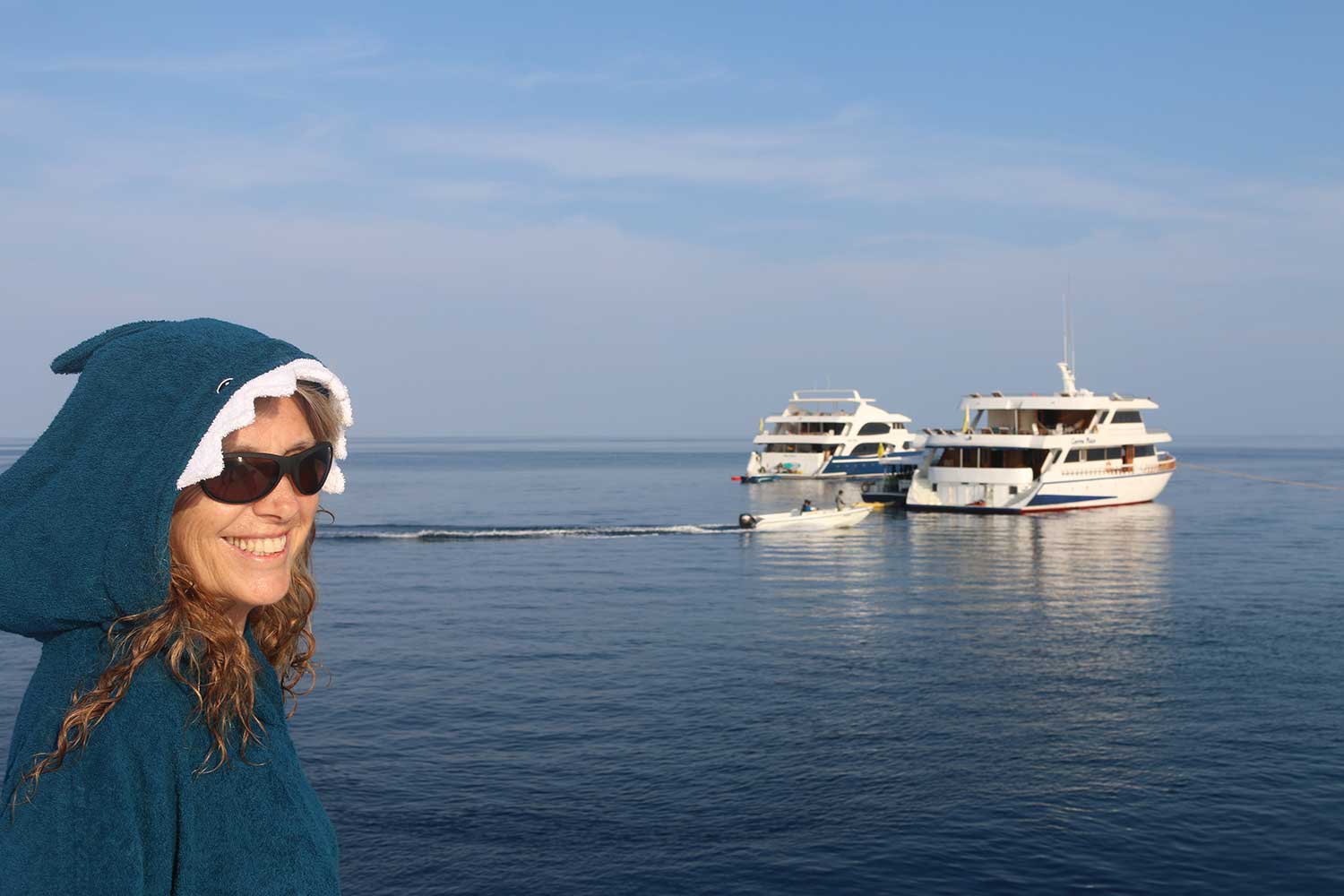The BEST SEVEN – Extreme South Atoll – Liveaboard Diving in Maldives
Discover the Magic of a Diving Cruise in the Southern Atolls of the Maldives

Embarking on a diving cruise through the southern atolls of the Maldives offers an incredible opportunity to discover a more remote and tranquil side of the archipelago. With some of the most untouched underwater ecosystems, the southern Maldives promises thrilling dives, from encounters with large pelagic species to exploring vibrant coral gardens teeming with life. The southern atolls, including the renowned LAAMU Atoll, HUVADHOO Atoll, and ADDU Atoll, offer a variety of dive sites that are often less crowded and more pristine than their northern counterparts.
Whether you’re looking to dive with manta rays, encounter the elusive whale sharks, or explore the stunning underwater topography of deep channels, the southern atolls provide a perfect blend of excitement and natural beauty. Onboard your liveaboard vessel, enjoy luxurious amenities, expert dive guides, and a blend of comfort and adventure as you explore this hidden diving gem. From idyllic white-sand beaches to lively underwater ecosystems, a diving cruise in the southern Maldives offers the ultimate escape into nature’s wonders.
Flexible itineraries through the stunning Extreme South Atolls.
The map shows the full area of the Extreme South Atolls of the Maldive, but each week we follow different routes. Itineraries vary depending on weather conditions, guest preferences, and where the best experiences can be had.
Every cruise is unique!
Top Dive Sites in the Southern Atolls of the Maldives
The southern Maldives is home to an incredible variety of dive sites.
In these atolls, diving takes place most in the channels where current attact large groups of fish, offering some of the most exciting and dynamic underwater experiences in the world.
Here are some must-visit dive sites in the region, showcasing the area’s rich biodiversity and dramatic underwater landscapes:

Fushi Kandu (Laamu Atoll)
Fushi Kandu is considered one of the most beautiful dive sites in the archipelago, it is home to a wide variety of marine life: gray sharks, silver tips and in some cases tiger sharks, barracudas and eagle rays, as well as schools of fish such as fusiliers, jacks and snappers. The best way to see sharks is to stay in the blue on the step line to see sharks in drift.
Mundhoo Kandu (Laamu Atoll)
This pass offers beautiful coral formations on both corners. Amazing channel full of life. Usually we dedicate the dive to the south corner, generally full of lots of reef fish. The pass has a double step, the first on 25 meters, the second between 35 and 40 meters. With the current coming in from E-W possibility of seeing pelagic fish in particular gray sharks and white tip sharks.
Maamendhoo Kandu (Huvadhoo Kandu)
It’s one pass a little too wide to be crosse, therefore, the dive is carried out on one of the two corners.
The north corner with its internal reef is very nice and it is not difficult to see gray sharks and green turtles, to the south of the channel there is a greater presence of sharks therefore a longer stay on the step (+ 30 meters) and then parade internally along the reef and finish the dive, on a very small thila full of green turtles.
Kondey Coral Garden (Huvadhoo Kandu)
This dive site is located in the middle of the channel. The site is almost 2km long and is home to dozens of hard coral species that cover it for over 1km. The main attraction is the coral garden, but you can also spot small species of fish living there. This site is very easy, but divers should be experienced and have excellent buoyancy control so as not to damage this precious coral garden.
Vilingili Kandu (Huvadhoo Kandu)
This channel is very rich in pelagic. Among the best known of the atoll. The best part is definitely on the step of the channel where is possible to see so much pelagic, especially gray sharks. Also the two reefs to the north and south, the internal walls of the channel, offer different situations of marine encounters and are, morphologically, slightly different even if they belong to the same channel.
Maarehaa Kandu (Huvadhoo Kandu)
Together with Vilingili Kandu the two passes that deserve the trip to this atoll. Pass by the characteristics that allow the dive to start at any point, on the north or south corner, or even also jumping in the center of the channel. Many gray sharks, sometimes groups of eagles ray, barracudas and trevally are almost always present, on the internal reef instead the constant presence of green turtles and a good quantity of reef fish. The south corner offers a magnificent underwater landscape as the canyon where it is possible to meet eagles ray, green turtles and stingrays. Beautiful location for photographers too.
NIGHT with the WHALE SHARKS (Huvadhoo Kandu)
In the Huvadhoo Atoll, from January to April, it is possible to experience unique night-time encounters and swims with whale sharks. Powerful lights positioned at the stern of boats attract plankton, the main food source for these gentle giants of the sea. This phenomenon draws the whale sharks near the surface, offering participants the opportunity to swim alongside them in a safe and controlled environment.
Koddu SHARK POINT (Huvadhoo Kandu)
Shark Point—also known as the “Shark Hotel”—is one of Huvadhoo Atoll’s premier channel dives, situated directly in front of Kooddoo Harbour. The site features a wide sandy-bottomed channel at depths of roughly 28–30 m, flanked by coral blocks and steep reef walls, and is renowned for strong currents that attract large aggregations of pelagic sharks. Here, spinner sharks and grey reef sharks dominate the scene, with occasional bull shark and guitarfish sightings, while the inside reef walls often harbor foraging sea turtles and eagle rays. Excellent visibility and dynamic drift-diving conditions make Shark Point a must for advanced divers seeking high-adrenaline shark encounters.
TIGER ZOO (Fuvahmulah Atoll) – THE DANCE OF THE TIGERS
Easy easy dive to see tiger sharks. The dive takes place at the mouth of the tiny port of the island, a plateau of 10-12 meters deep. We position ourselves by creating a line and we stand side by side waiting for the sharks that are attracted by scraps of tuna fragments of tuna placed on the seabed. The dive on the plateau lasts a maximum of 30 minutes after which you move to one of the two reefs in favor of the current, to finish the dive. Your pulse hammers in your ears as a 3- to 4-meter apex predator drifts past, its amber eyes unblinking yet utterly nonchalant—an intimate ballet between diver and wildurance that few places on Earth can offer.
Maa Corner (Addu Atoll) – MANTA POINT CLEANING STATION
Easy dive, current permitting, sees almost at the bottom of a channel, between 18 meters and 25 meters, a large block of massive coral, generally rich in a good amount of reef fish, and which is a cleaning station for manta rays . In these cases you stay close to the coral block for almost the entire time of the dive, obviously evaluating consumption and bottom times, and then go up along the wall where there are beautiful acropora tables and it is easy to see grey sharks and white tip sharks as well as several Napoleon fish and sea eagles.
British Royalty Wreck (Addu Atoll)
British Loyalty is 134 meters long and lies at a depth of 33 meters, lying on the port side. From the surface, you can see the starboard railings 15 meters below. The propeller is located at a depth between 23m and 28m and originally had 4 blades, each 2m long. The body of the ship is covered with table corals, soft corals, gorgonians and black corals. There is a resident leaf fish on the upper side towards the bow and turtles are regularly seen.
When to Visit the Southern Atolls of the Maldives
The southern atolls are a year-round diving destination, with each season offering unique marine experiences.
Anyway, our Cruises are scheduled from January to April – during the DRY MONSOON Season- to ensure the best possible weather conditions for this typer of itinerary. The calm seas and clear skies offer incredible underwater visibility, allowing divers to fully appreciate the vibrant coral reefs and abundant marine life.




